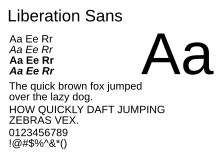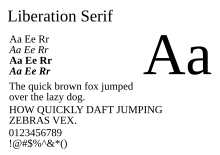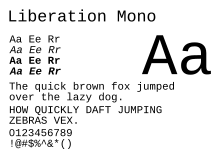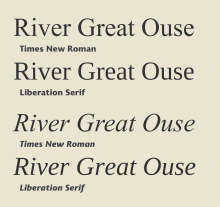Liberation fonts
 | |
| Category | Sans-serif |
|---|---|
| Classification | Neo-grotesque |
| Foundry | Ascender Corp. |
| License |
SIL Open Font License (version 2 onwards) GPL v2 with some exceptions (older versions)[1] |
| Variations | Arimo |
| Metrically compatible with | |
 | |
| Category | Serif |
|---|---|
| Classification | Transitional |
| Foundry | Ascender Corp. |
| License |
SIL Open Font License (version 2 onwards) GPL v2 with some exceptions (older versions)[1] |
| Variations | Tinos |
| Metrically compatible with | |
 | |
| Category | Monospace |
|---|---|
| Foundry | Ascender Corp. |
| License |
SIL Open Font License (version 2 onwards) GPL v2 with some exceptions (older versions)[1] |
| Variations | Cousine |
| Metrically compatible with | |

Liberation is the collective name of four TrueType font families: Liberation Sans, Liberation Sans Narrow, Liberation Serif and Liberation Mono. These fonts are metrically compatible with the most commonly used fonts on the Microsoft Windows operating system and the Microsoft Office software package (Monotype Corporation's Arial, Arial Narrow, Times New Roman and Courier New, respectively), for which Liberation is intended as a free substitute.[2]
Characteristics
Liberation Sans, Liberation Sans Narrow and Liberation Serif closely match the metrics of Monotype Corporation fonts Arial, Arial Narrow and Times New Roman, respectively.
Liberation Mono is styled closer to Liberation Sans than Monotype's Courier New, though its metrics match with Courier New.
The Liberation fonts are intended as free, open-source replacements of the aforementioned proprietary fonts.
- Comparison of initial release of Liberation fonts to the fonts with which they are designed to be metric compatible
 Comparison of Liberation Sans with Arial
Comparison of Liberation Sans with Arial Comparison of Liberation Serif with Times New Roman
Comparison of Liberation Serif with Times New Roman Comparison of Liberation Mono with Courier New
Comparison of Liberation Mono with Courier New
Unicode coverage
All three fonts supported IBM/Microsoft code pages 437, 737, 775, 850, 852, 855, 857, 858, 860, 861, 863, 865, 866, 869, 1250, 1251, 1252, 1253, 1254, 1257, the Macintosh Character Set (US Roman), and the Windows OEM character set, that is, the Latin, Greek, and Cyrillic alphabets, leaving out many writing systems. Extension to other writing systems was prevented by its unique licensing terms.[3] Since the old fonts were replaced by the Croscore equivalents, expanded Unicode coverage has become possible.
History
The fonts were developed by Steve Matteson of Ascender Corporation as Ascender Sans and Ascender Serif. A variant of this font family, with the addition of a monospaced font and open-source license, was licensed by Red Hat, Inc. as the Liberation font family.[4] Liberation Sans and Liberation Serif derive from Ascender Sans and Ascender Serif respectively; Liberation Mono uses base designs from Ascender Sans and Ascender Uni Duo.
The fonts were developed in two stages. The first release of May 2007 was a set of fully usable fonts, but they lacked the full hinting capability. The second release, made available in the beginning of 2008, provides full hinting of the fonts.
In April 2010, Oracle Corporation contributed the Liberation Sans Narrow typefaces to the project.[5] They are metrically compatible with the popular Arial Narrow font family.[6] With Liberation Fonts 1.06 the new typefaces were officially released.[7]
Distribution
Version 2.00.0 or above
As of July 18, 2012, Liberation Fonts 2.00.0 and above are a fork of the Chrome OS Fonts released under the SIL Open Font License, and no longer include the Liberation Sans Narrow fonts.[2]
Older versions
Red Hat licensed these fonts from Ascender Corp under the GNU General Public License with a font embedding exception, which states that documents embedding these fonts do not automatically fall under the GNU GPL. As a further exception, any distribution of the object code of the Software in a physical product must provide the right to access and modify the source code for the Software and to reinstall that modified version of the Software in object code form on the same physical product on which it was received.[8] Thus, these fonts permit free and open-source software (FOSS) systems to have high-quality fonts that are metric-compatible with Microsoft software.
The Fedora Project, as of version 9 was the first major GNU/Linux distribution to include these fonts by default and features a slightly revised versions of the Liberation fonts contributed by Ascender. These include a dotted zero and various changes made for the benefit of internationalization.[9][10]
Some other GNU/Linux distributions (such as Ubuntu, OpenSUSE[11] and Mandriva Linux[12][13]) included Liberation fonts in their default installations. The open source software OpenOffice.org included Liberation fonts in its installation packages for all supported operating systems.[14][15][16][17][18]
Due to licensing concerns with fonts released under a GPL license, some projects looked for alternatives to the Liberation fonts.[3] Starting with Apache OpenOffice 3.4, Liberation Fonts were replaced with the Chrome OS Fonts[19] – also known as Croscore fonts: Arimo (sans), Cousine (monospace), and Tinos (serif) – which are newer versions of the same designs but made available by Ascender Corporation under the Apache License 2.0.
See also
Typefaces
- Croscore fonts – derived and extended from Liberation fonts
- Droid – a font family by the same font designer
- Gentium – an Open Font License font which defines roughly 1,500 glyphs covering almost all the range of Latin characters used worldwide
- Linux Libertine – another free software serif typeface with OpenType features support
- Nimbus Roman No. 9 L, Nimbus Sans L and Nimbus Mono L – another series of free software fonts also designed to be substituted for Times New Roman, Arial and Courier.
Other
References
- 1 2 3 "License", Liberation Fonts, Fedora .
- 1 2 Liberation Fonts, Fedora
- 1 2 Willis, Nathan (2012-06-19). "Liberation fonts and the tricky task of internationalization". LWN. Retrieved 2012-07-16.
- ↑ Webbink, Mark (2007-05-09). "Liberation Fonts". Red Hat. Archived from the original on 2008-01-17.
- ↑ "Liberation-fonts changelog". Retrieved 2010-11-11.
- ↑ "OpenOffice.org 3.3 New Features". Retrieved 2010-11-11.
- ↑ Pravin, S (Jul 2010), Liberation Sans release 1.06 (Blogger) (World wide web log), Google .
- ↑ License.txt - LICENSE AGREEMENT AND LIMITED PRODUCT WARRANTY, LIBERATION FONT SOFTWARE, retrieved 2010-01-15
- ↑ Bugzilla entries for the revised Liberation fonts included in Fedora 9, Red Hat Bugzilla – Bug List
- ↑ Bugzilla screenshot of the revised Liberation Mono font with dotted zero, Red Hat Bugzilla - Bug #252149 (Image)
- ↑ "opensuse-oss-i586/liberation2-fonts-2.00.1-2.1.1.noarch.rpm". Archived from the original on 2014-01-15.
/liberation2-fonts-2.00.1-2.1.1.noarch.rpm
- ↑ Mandriva Linux 2008 Release Tour, archived from the original on 2010-06-19, retrieved 2010-04-04,
integrated into Mandriva Linux 2008
- ↑ "Packages included in Mandriva Linux 2010 Free x86-64 linked from", wiki.mandriva.com/en/Mandriva_Linux_2010#Package_Lists, archived from the original on 2010-01-25, retrieved 2010-04-04,
FREE-2010-x86_64 /main/fonts-ttf-liberation-1.04-2mdv2010.0.noarch
- ↑ "OpenOffice.org Wiki - External/Modules". Retrieved 2010-01-31.
- ↑ "OpenOffice.org - Issue 77705 - Liberation font and OOo". Retrieved 2010-02-05.
- ↑ "OpenOffice.org - Issue 104723 - Update Liberation fonts to v1.05.1.20090721". Retrieved 2010-02-05.
- ↑ "OpenOffice.org - Issue 111719 - Update Liberation fonts to v1.06". Retrieved 2010-10-28.
- ↑ ooo-build - patches - dev300 (OpenOffice.org 3.xx patches), retrieved 2010-01-31
- ↑ "Liberation vs Croscore fonts".
External links
| Wikimedia Commons has media related to Liberation fonts. |
- Official website for sources and TTF files
- Sources for development
- Liberation Sans font (Red Hat-related), Fontsy .